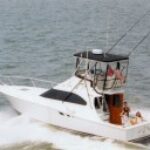Forum Replies Created
-
AuthorReplies
-
May 14, 2022 at 1:28 pm #131681

Kevin CummingsParticipantThanks Tony, I’m probably overthinking this setup and your answers make sense to me. I guess I thought that the main coolant return path was via the heat exchanger (when hot?) One followup question – The coolant bypass path – is it via the 1″ hose or some magic internal path. I’m at the end of a long maintenance path over the winter, will send you some pics when done!
Update – I just signed up/in for QSOL and can now see the service manual – According to this pic, it appears that the bypass path is an internal passage to the water pump.
Thanks for your help!
Kevin
May 2, 2022 at 9:52 am #131151
Kevin CummingsParticipantHi Lawrence, After spending the past few months maintaining everything in my twin engine room (new R/W Pumps, Fuel Cooler Removal, new Gear Coolers, and now working on the Heat Exchangers, I’m now seeing the wisdom of regular Fresh Water flushing as recommended by Seaboard Marine.
I too have the Perko caps installed for a long time, and had 90 degree fittings drilled/tapped in to the caps along with a shutoff valve. Very similar to your setup, except the for the horizontal orientation as I need space to access this tight area behind my engines.
In Picture 1 you can see my setup which has hoses connected to strainers under the engines (Crash Valves) to be used in an emergency. The fittings are also used when performing my annual winterizing.
In picture 2 you can see how I’m starting to modify this setup with the addition of 3-way valves. This will allow me to connect a single freshwater hose to flush the engines regularly after use, while also maintaining the crash valve setup. Now, I won’t need to disconnect/reconnect any plumbing to flush the engines (one at a time), just switching the valves.
I like the clear 3/4” hose to actually see the water flows. Also will have tie wraps on the valves to prevent accidental movement while running.
Hope this gives you some ideas
Kevin
May 2, 2022 at 5:16 am #131135
Kevin CummingsParticipantHi Lawrence, After spending the past few months maintaining everything in my twin engine room (new R/W Pumps, Fuel Cooler Removal, new Gear Coolers, and now working on the Heat Exchangers, I’m now seeing the wisdom of regular Fresh Water flushing as recommended by Seaboard Marine.
I too have the Perko caps for a while, and had 90 degree fittings drilled/tapped in to the caps with a shutoff valve. Very similar to your setup, except the horizontal placement of the valve allows more room for me to maneuver into a very tight space that I must access often. I use the valves for both winterizing and for connection to under each engine strainers ( aka: Crash Valves), to be used in an emergency to pump water. (See Picture 1).
As I have been reading this site, I’m in the process of modifying this setup to make it easier to connect one freshwater hose to flush the engines (one at a time), which I will do regularly, and also for annual winterizing. The 3-way valves will allow me to flush the engines, without disconnecting/re-connecting any plumbing – just open/close the appropriate valves.
Not completed yet, but you can see the basic setup from picture 2.
I also will have tie wraps on the valves to strainer body when done, to prevent any accidental opening.
Hope this gives you some ideas. Kevin
January 19, 2022 at 7:57 am #125384
Kevin CummingsParticipantThank you Tony,
We appreciate everything you do for us end-users trying to understand and maintain the Cummins products.
Kevin
-
AuthorReplies
